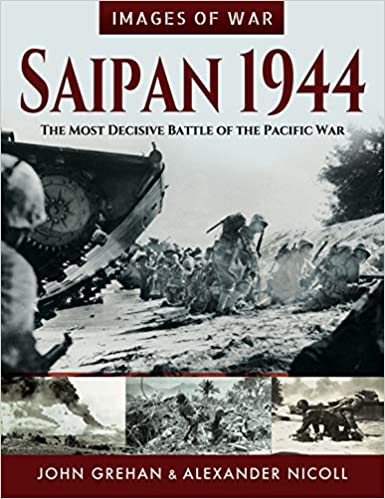Reviewed by John Grady
The weeks long gruesome land battle by Marines and soldiers to take mountainous Saipan included a doomed but deadly Banzai charge of Japanese soldiers followed by mass civilian suicides rather than surrender to the Americans. Those two events are often what is remembered most in the struggle to control the most heavily defended island by the Japanese in the Marianas in the summer of 1944, a battle waged at the same time as Allied forces were fighting to expand their foothold in France and end the stalemate in Italy. The resultant Seabee grading of Saipan and Tinian for airfields paired with the effect on naval events in the skies and waters hundreds of miles away make the Saipan campaign “the most decisive” of the Pacific war.
During those fraught days of brutal combat on Saipan, naval aviators and sailors wrested control of the Philippine Sea and destroyed much of what was left of the Japanese battle fleet, aircraft, pilots and crews in what became known as “the Great Marianas Turkey Shoot.” “Get the carriers” had been the American Navy mantra that summer of 1944 in ready rooms; and they did in the Battle of the Philippine Sea.
In the coda to the Saipan campaign, the first wave of American B-29 Superfortresses arrived on those islands. They now were based close enough to make the Japanese home islands targets for continuous, round-the-clock bombing.
John Grehan and Alexander Nicoll, veteran military history writers, wrap all this into Pen & Sword’s “Images of War” World War II story of Saipan but do not expect James Hornfischer or Ian Toll epics on the Pacific War or James Scott’s detailed accounting of the fight for Manila. Saipan 1944 lives up to the publisher’s claim that “The success of our Images of War series is due to the copious use of collectors’ graphic and rare contemporary images, supported by authoritative captions and lively text.”
Page after page of this book is filled with images. Many are stock or familiar like that on pp.78-79 of a two Marines, one tossing a grenade and the other getting ready to throw his own in the fight for the Central Mountain Range. Some images are gripping. One, on p. 170, depicts two of the very few Japanese soldiers who surrendered and another, on p. 171, depicts three Catholic nuns who survived being caught in a vicious crossfire. Others are shocking, like the overleaf on pp.148-49 showing the Japanese dead after the Banzai charge. This makes Saipan 1944 worth buying and examining page by page, image by image.
The “captions”—or “cutlines,” in the parlance of newspaper and periodicals—include a few extended passages. One, on p. 55, remarks on the importance of preventing “friendly fire” casualties, while another, on p. 152, recounts the awarding of a posthumous Medal of Honor in 2002 to Captain Edmund G. Love, a dentist, for his actions in manning a machine gun during the Banzai charge.
As critical as Saipan, the Philippine Sea, and the positioning of the B-29s were to victory over Japan, Saipan 1944 neglects to detail some events and personalities that could have been scenes, chapters, or possibly full-length books unto themselves. In particular, the book does not elaborate on Marine Corps Lt. Gen. Holland Smith’s relief of Army Maj. Gen. Ralph Smith’s command of the 27th Infantry Division on June 24. Put in the simplest terms, Ralph Smith was fired for, in Holland Smith’s eyes, not moving more aggressively on the Japanese dug into mountainsides or hidden in caves. The decision enflamed inter-service relations for years, yet the bitterness that ensued between Marine and Army commands can only be hinted at in a book like this. An understanding of the immediate impact of Ralph Smith’s firing can only gleaned from Saipan 1944 by gathering information scattered across the textual lead-ins to chapters and the captions under pictures, but again, Saipan 1944 was not aimed at doing what Scott’s Rampage: Macarthur, Yamashita, and the Battle of Manila achieved. That was never the publisher’s intent.
As a final note, and a very positive one, the textual lead-ins to the chapters are superb scene-setters for what follows. Those tightly written paragraphs show the professionalism that characterizes this book, this series, and its authors, Grehan and Nicoll.
John Grady is the author of “Matthew Fontaine Maury: Father of Oceanography”. Grady has contributed to Sea History, Naval History, Civil War Monitor, and the New York Times “Disunion” series. He was also a blogger for the Navy’s Sesquicentennial of the Civil War.
Saipan 1944: The Most Decisive Battle of the Pacific War (John Grehan and Alexander Nicoll, Frontline Books, Barnsley, South Yorkshire, Great Britain, 2021).


